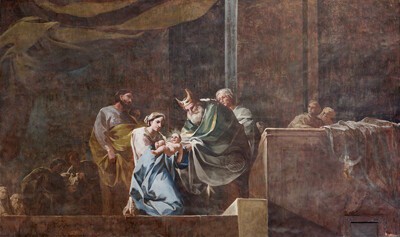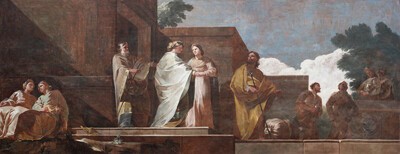- Cronología
- Ca. 1774
- Ubicación
- Church of the Monastery of Aula Dei, Zaragoza, Spain
- Dimensiones
- 306 x 790 cm
- Técnica y soporte
- Oil on plaster
- Reconocimiento de la autoría de Goya
- Documented work
- Titular
- Instituto Chemin Neuf
- Ficha: realización/revisión
- 07 Oct 2010 / 13 Jun 2023
- Otros títulos:
-
Nativity of the Virgin Mary (La natividad de la Virgen María)
The scene, divided into three sections, focuses on a main group of figures within the composition: the women who care for the newborn Mary. A ray of light beams down on her from the emblem that represents her depicted above, which is held by two small angels that float on a mass of clouds. The light reinforces the importance of the main figures, also emphasised by a brighter, more vivid colour scheme: their clothing is executed predominantly in yellows and blues. Next to the group of women and set slightly further back from the foreground we can see Saint Joachim leaning on a staff and clothed in a red ochre cloak. Behind him is another figure shown at half-length in the lower section of the composition.
The scene takes place under a kind of shelter. On the left and in the open air there is a group of men carrying rods who seem to be chatting or watching over their animals, unaware of the main event taking place in the painting. This section was in a very bad state of conservation until it underwent restoration work in 1978-79.
On the right we can see another group of figures: Saint Anne on her bed accompanied by the women who attend to her needs. The original paintwork by Goya was lost in its entirety from this section, and the current work was carried out by the Buffet brothers.
See Revelation to Saint Joachim and Saint Anne. for a history of the complete set of works housed in this church.
Restauradas por Carlos Barboza y Teresa Grasa entre 1978 y 1979.
Restaurada por el Gobierno de Aragón entre 2009 y 2011: se hizo un estudio del estado de conservación, limpieza, consolidación, eliminación de sales, análisis y estudios ambientales, eliminación de elementos nocivos para la película pictórica, saneamiento y restauración de grietas, restauración de marcos y dotación de una iluminación apropiada.
-
Goya, su tiempo, su vida, sus obrasMadridTipografía de Manuel G. Hernández, Impresor de la Real Casa1887p. 462
-
Vie et ouvre de Francisco de GoyaParísOffice du livre1970pp. 39-41 (il.), cat. 42-48
-
BarcelonaPolígrafa1970vol. I, pp. 241-242
-
Las pinturas de Goya en la Cartuja de Nuestra Señora de Aula-DeiZaragozaMutua de Accidentes de Zaragoza1975
-
Sobre los documentos conservados en la cartuja de Aula DeiSeminario de Arte AragonésZaragoza1980pp. 119-122
-
Goya y Aragón. Familia, amistades y encargos artísticoscol. Col. Mariano de Pano y RuataZaragozaCaja de Ahorros de la Inmaculada de Aragón1995pp. 107-118 (il.)
-
Las pinturas murales de Goya en AragónMadridGobierno de Aragón y Electa España1996pp. 39-47
-
Las pinturas murales de Goya en la cartuja de Aula DeiFundación Goya en Aragón y Turner2008vol. II, pp.123-137
-
Goya antes del viaje a Madrid (1746-1774)BarcelonaGalaxia Gutenberg/Círculo de Lectores y Fundación Amigos del Museo del Prado2010pp. 315-336






